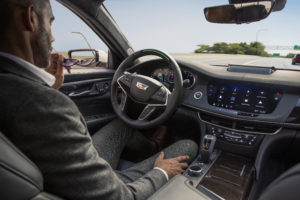
GM’s new ADAS boasts hands-free technology
By onAnnouncements | Market Trends | Technology
General Motors (GM) is rolling out a new advanced driver assistance program (ADAS) that it says will enable hands-free driving 95% of the time.
The automaker shared details about its next-generation system, Ultra Cruise, this week and said it will first be launched on the Cadillac Celestiq, a hand-built electric vehicle expected to begin production in December.
“GM’s fundamental strategy for all ADAS features, including Ultra Cruise, is safely deploying these technologies,” said Jason Ditman, GM’s chief engineer of Ultra Cruise. “A deep knowledge of what Ultra Cruise is capable of, along with the detailed picture provided by its sensors, will help us understand when Ultra Cruise can be engaged and when to hand control back to the driver. We believe consistent, clear operation can help build drivers’ confidence in Ultra Cruise.”
The OEM said Ultra Cruise-equipped vehicles will contain more than 20 sensors, with a driver attention system in place to ensure the vehicle’s pilot is alert.
“The destination-to-destination hands-free system will use more than just cameras to ‘see’ the world,” GM said in a press release. “Ultra Cruise uses a blend of cameras, short- and long-range radars, LiDAR behind the windshield, an all-new computing system and a driver attention system to monitor the driver’s head position and/or eyes in relation to the road to help ensure driver attention. These systems work together through ‘sensor fusion’ to provide Ultra Cruise with a confident, 360-degree, three-dimensional representation of the vehicle’s surroundings.”
Although the technology is first being introduced on the Celestiq, which will retail for $300,000 and up, GM said it will eventually expand the technologies to additional models at various price points.
A spokeswoman told Repairer Driven News that Ultra Cruise is a Level 2 system.
“GM’s fundamental strategy for all ADAS features, including Ultra Cruise, is safely deploying these technologies,” the spokeswoman said. ”A deep knowledge of what Ultra Cruise is capable of, along with the detailed picture provided by its sensors, will help us understand when Ultra Cruise can be engaged and when to hand control back to the driver.”
Although drivers can expect to have a hands-free experience for most journeys, there are exceptions about 5% of the time, she added.
“The 5 percent represents challenging maneuvers that a driver would not encounter on a typical route, like a roundabout with multiple lanes, entrances and exits. In these situations, we hand control back to the driver well before the maneuver takes place, the driver executes the task, then the system automatically re-engages.”
In the event of a collision, she said a vehicle with Ultra Cruise can be repaired at GM dealerships and at the OEM’s certified repair networks. Both should adhere to the procedures, tools and systems to properly complete repairs, she added.
GM is among several automakers racing to advance ADAS technologies through autonomous driving technology that allows the vehicle to take responsibility for driving on specific stretches of roadway and under certain conditions.
Mercedes-Benz became the first to offer Level 3 autonomy in the U.S. when its self-driving system, Drive Pilot, was approved for use in Nevada last month.
Mercedes said during the Consumer Electronics Show (CES) in Las Vegas that the state’s Department of Motor Vehicles approved its application and was preparing the certificate of compliance. The DMV will allow Mercedes to self-certify that the Level 3 autonomous system is safe for use on public roads. Mercedes is also seeking approval for Drive Pilot use in California.
However, not everyone’s on board with fully and partially autonomous vehicles, with the IIHS asserting that technology should never fully replace drivers.
Speaking during a virtual Capitol Hill briefing March 7, IIHS’s president David Harkey said that while he supports many modern technologies including driver assistance tools, he can’t get behind self-driving cars.
“We firmly believe in technology for vehicle safety and the potential it has to reduce the tragic toll on our roadways,” Harkey told legislators in prepared remarks. “But I want to be clear about where we see the greatest benefits for vehicle safety technology.
“We believe it is critical for the driver to remain engaged in the driving task at all times and always be responsible for all actions of the vehicle. We do not believe in the promise of technology to completely replace drivers and for the vehicle to assume all responsibility for vehicle operations.”
Images:
A 2019 Cadillac CT6 runs Super Cruise. (Provided by Cadillac)
